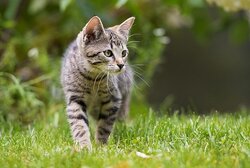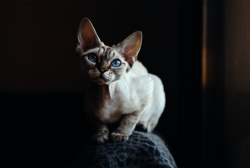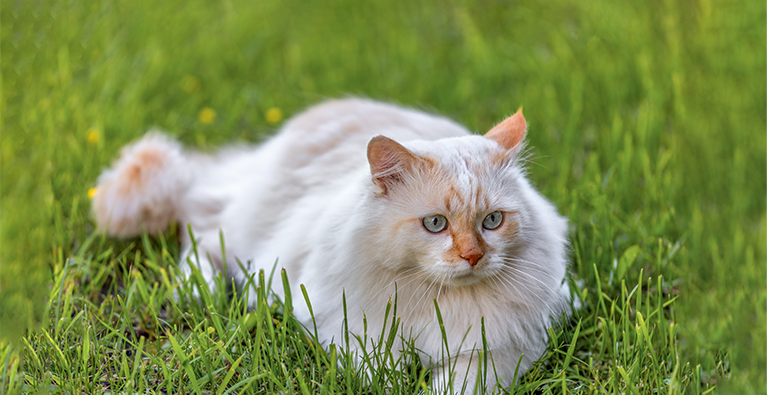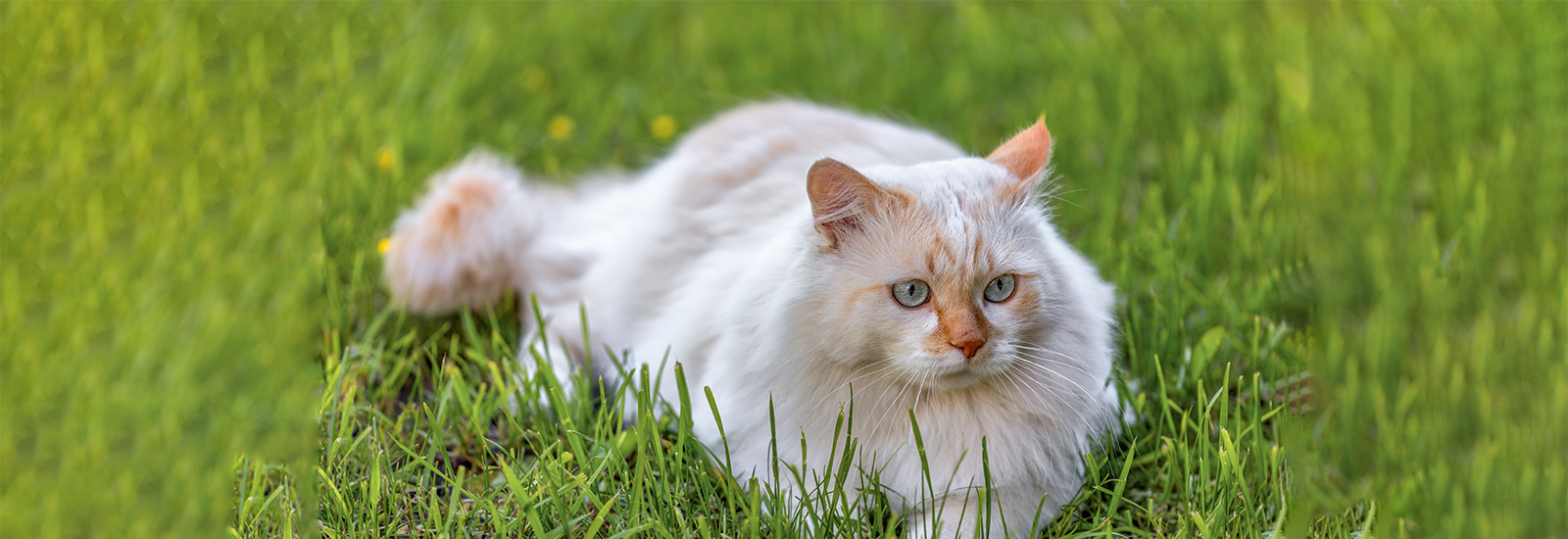Turkish Van
Some breeds of cat are almost impossible to tell apart. However, the spirited and highly active Turkish Van can be easily recognised thanks to its light-coloured fur and its bushy tail that has a completely different colour.
Profile of the Turkish Van
- Size large
- Weight female: approx. 5.5 kg, male: approx. 7.5 kg
- Origin Turkey
- Build elongated body, very strong
- Length of fur medium-long
- Colour of fur white with coloured fur on the head and tail
- Grooming medium
- Behaviour high-spirited, playful
- Character intelligent, inquisitive
Appearance and character of the Turkish Van cat
The Turkish Van is a pure breed that is said to have been in existence for over 2000 years now. It has always had a white body with a few spots on its head. The tail is mainly brownish with pale rings. Depending on the breeding association, the colour of the tail and the markings on the head may also be cream, reddish-brown, blue, tortie or black. This distinctive two-tone colouring is the hallmark characteristic of this medium-sized to large breed of cat. Fittingly, these animals are occasionally born with eyes in two different colours. One is blue, while the other is green, amber or orange. These stand out in a particularly stunning way against the light-coloured fur. Although this breed of cat has a dense coat, it has no undercoat. Its magnificent fur, which is quite voluminous on the neck, chest, shoulders and hind legs, especially in winter, consists exclusively of upper coat.
The Turkish Van has a fascinating character: it is no wallflower, and knows exactly what it wants and how to get it. This intelligent breed of cat will urge you to play with it, loudly announce its mealtimes and snuggle up to you when it wants a cuddle. It is assertive, high-spirited and playful, which makes the breed very popular with children. It is also highly resistant to stress, inquisitive and energetic. Although it also needs plenty of sleep, life will never be boring with a Turkish Van.
Keeping and caring for a Turkish Van
Turkish Van cats are curious and full of energy. They would therefore have no objection to being allowed to go outside – if this is safe for them – but they can also manage without it. Indoor cats can lack social contact, so they will always be happy to be kept as a pair. After all, wild chases through your home with another cat are more fun than with a two-legged friend. However, Turkish Vans would never want to be without their humans. The relationship they have with their owners is often very close, which is why they do not like having to stay at home alone for extended periods of time. They love to be part of their owner’s life and really enjoy playing together and being stroked. You should also provide your cat with a variety-packed cat tree, activity fun boards and other toys. This will provide mental challenges for this clever breed of cat and keep it occupied in an ideal way.
Grooming is less complicated than it might at first seem. Although the Turkish Van has luxuriant fur, especially in winter, this only consists of a long upper coat. With no undercoat, there is little risk of the fur becoming matted. Despite this, you should comb your pet’s coat regularly. When it has its summer coat, combing once a week will suffice; in winter, twice a week is better. If moulting season is coming up, three times is advisable, because this prevents the cat from swallowing too much fur, which could cause problems in its gastrointestinal tract.
Nutrition
Whether it’s a kitten, an adult cat or a senior – the food for a Turkish Van cat should always be of high quality and tailored to its age. Cats are carnivores by nature, so cat food should always contain a high proportion of meaty ingredients. Sugar, flavour enhancers and artificial colourings and preservatives do not belong in the food.
animonda has the ideal food for every stage of your cat’s life. You can choose between kitten, adult and senior cat food. The products are specially formulated to meet the specific nutritional requirements of the different life stages of cats. This provides the best foundation for your pet to enjoy a long and healthy life.
Turkish Van: health
The Turkish Van is a rare breed of cat. This means that there is an increased risk of inbreeding, which can lead to immunodeficiency diseases and a reduced life expectancy. If you choose this breed, you should make sure that you only buy your pet from a trustworthy, responsible breeder.
Typical diseases in the breed may be associated with its white fur. This is due to the mutation of the pigment genes that produces the colour white. This increases the predisposition to blindness, hearing loss and eye tremors. It is of some advantage that the Turkish Van is not a pure white breed of cat, but instead has some coloured markings on its head and tail. According to the breed standard, these areas should not make up more than 20 per cent of the total coat.
Just like the Turkish Angora, the Turkish Van can also suffer from ataxia. This is a disability that can result primarily in balance disorders. Affected cats have an unsteady stance and can fall over when walking. The condition can be improved with therapy, although adjustments will need to be made in the home. For example, a carpet makes walking much easier than slippery tiles or laminate flooring. Stairs should be closed off, litter trays should not have a high rim and food bowls should ideally be placed in an elevated position.
History and breeding
There are many types of cats that are the result of cross-breeding. The Turkish Van, however, is a pure breed. It has never been and is still not interbred with other cats. It is said to have existed in this form for over 2000 years now. Its origins can be traced back to eastern Turkey, around Lake Van, the country’s largest lake. It is situated at an altitude of 1648 metres. While in summer it can be a pleasant 28 degrees here, in winter it is below zero. Over the years, the Turkish Van has adapted to this and has a long, thick coat in the winter months.
There are frequent reports that this breed is not at all afraid of water. This may be because of Lake Van and its numerous tributaries. People assume that some cats used to hunt for fish there, or perhaps still do. Owners of Turkish Van cats should therefore exercise caution: it could well be that their pets have no fear of a full bathtub, an aquarium or a garden pond.
Sadly, there are no reliable figures with regard to breeding in Turkey. It was, however, very fortunate for the breed that the two English women Sonia Halliday and Laura Lushington travelled through Turkey in 1955 and came across these animals. They were so impressed by the cats that they were allowed to take two of them home with them. Almost the entire breeding programme outside Turkey was founded on these two specimens and the two or three animals that were imported at a later date. No more cats were allowed to be exported from Turkey. This was even made a criminal offence.
It did not take long for the breed to be recognised by the British organisation ‘Governing Council of the Cat Fancy’. In 1960, the European governing body FIFe also officially recognised the Turkish Van. The first animals were brought to the USA in 1882. In 1994, the Cat Fanciers’ Association finally acknowledged the breed. Breeding seems to have been secured for the time being, but the Turkish Van is still one of the world’s rarest breeds of cat.
You may also like this

Getting your cat used to beeing outdoors
This is how you get your cat used to being outdoors

Feeding kittens - nutrition tips
What small kittens need for healthy development

Good cat food
How to recognize good cat food for your darling

Devon Rex
Their thin and curly hair make the breed particularly

